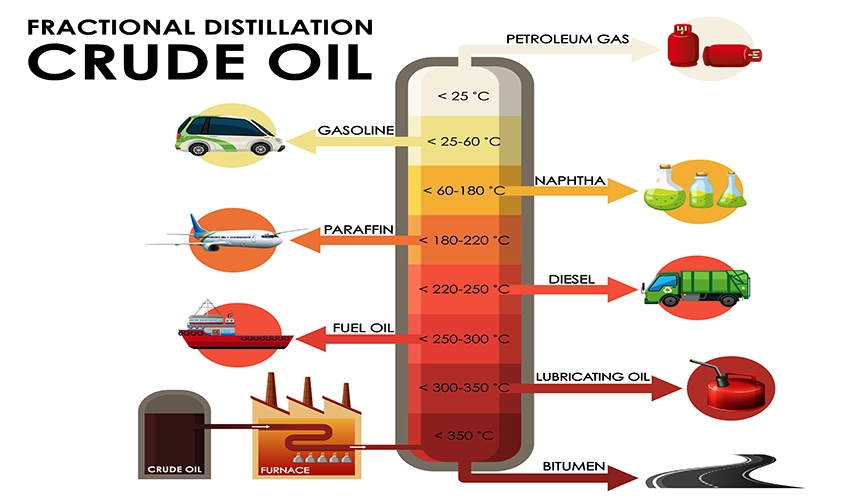تاریخ بروزرسانی(Update Date): 19th March 2025
What is Light Hydrocarbon?
Light hydrocarbons refer to hydrocarbons that have between 5 to 12 carbon atoms in their carbon chain. For example, pentane is a type of light hydrocarbon that contains 5 carbon atoms. These compounds, due to having molecules with lower molecular weights, have become suitable options for producing various chemicals, fuels, and more. Light hydrocarbons, in order of molecular weight, include gasoline, naphtha, and kerosene, which will be introduced below.
Characteristics of Light Hydrocarbons
Light hydrocarbons have low boiling points and are very volatile, which makes them highly flammable. Therefore, it is essential to observe safety precautions regarding these products. These substances consist of non-polar molecules and are suitable solvents for organic chemicals.
Components of Light Hydrocarbons
Gasoline
In the distillation column, gasoline is positioned after LPG gas. Gasoline is a volatile and flammable liquid with a density of 0.68 grams per cubic centimeter. Due to its lower density compared to water, it floats on the surface. The most important factor in determining the quality of gasoline is its octane number; the higher the octane number, the larger the octane rating and the better the quality of the fuel.
Naphtha
Naphtha is considered a type of light hydrocarbon and includes hydrocarbons that contain between 5 to 12 carbon atoms in their carbon chain. Naphtha is colorless, but if it has a high content of aromatic compounds, it tends to appear yellow. In the distillation column, naphtha is positioned between gasoline and kerosene. Naphtha is divided into two categories: light and heavy. Light naphtha is primarily used as a solvent and thinner for paints and varnishes, while heavy naphtha is used to produce solvents and as a cleaner in dyeing processes.
Kerosene
Kerosene was primarily used in the past for household purposes, such as heating and cooking, but today, city gas and LPG have replaced it. In addition, kerosene is now used in aviation. Kerosene contains hydrocarbons with 10 to 15 carbon atoms, and its volatility and flammability are lower than those of gasoline, making it safer; however, its pollution potential is higher.
Applications of Light Hydrocarbons
- Solvent: Light hydrocarbons are often used as solvents and thinners in various industries, such as paint. In the paint industry, light hydrocarbons are added to dilute and reduce viscosity, making them easier to use.
- Feedstock for Petrochemicals: They are used in industries such as plastics and rubber. In the plastics industry, light hydrocarbons are utilized through polymerization processes to produce items such as bottles, pipes, and automotive parts.
- Fuel: These materials are used to produce high-octane gasoline and jet fuel.
- Production of Other Chemicals: Light hydrocarbons are also employed in the production of methanol, fragrances, sunscreen, and more.
Methods of Producing Light Hydrocarbons

There are various methods for producing light hydrocarbons, with two important methods being crude oil distillation and blending:
In the crude oil distillation method, after desalting, the oil is transferred to a heat exchanger to raise its temperature to 28 degrees Celsius. The oil then passes through a furnace, increasing its temperature to 400 degrees Celsius. Upon reaching this temperature, the crude oil separates into two phases: gas and liquid, and then enters the distillation column. In the distillation column, the obtained vapors rise to the top of the column, while the liquids, which include very heavy hydrocarbons, remain at the bottom. In this method, petroleum products are separated based on their boiling point distance from one another. At the top of the distillation column, there are light hydrocarbons between butane and diesel that convert to liquid after passing through the condenser.
Another method is blending, or mixing. As the name suggests, in this method, we mix materials together to obtain a light hydrocarbon with the desired characteristics. By analyzing the light hydrocarbon, one can determine its quality. As we know, heavy hydrocarbons have lower economic value and applications compared to light hydrocarbons. Generally, the product that is obtained directly from the refining of crude oil does not possess the necessary characteristics for use; therefore, the blending process is very effective.
Purchasing Light Hydrocarbons
Given the numerous applications of light hydrocarbons in various industries, the demand for purchasing these products has significantly increased. Light hydrocarbons play a vital role, particularly in the petrochemical industry, fuel production, and the manufacture of various chemicals. Due to the importance of this material, examining the quality of the product before purchase has become an essential step.
Before proceeding to purchase light hydrocarbons, a thorough and complete analysis of the quality of this product is necessary. This analysis includes examining the physical and chemical properties of the hydrocarbons, such as boiling point, density, purity level, and the presence of impurities. Additionally, criteria such as flash point and thermal stability should also be evaluated, as these specifications greatly affect the performance and final application of these hydrocarbons.
Kian Petroleum is not a supplier of hydrocarbons; however, when these products are offered in the international ring, it provides brokerage services for purchasing from the international energy exchange to its customers. These services include specialized consulting, facilitation of administrative procedures, ongoing support, and the provision of market reports and analyses.

